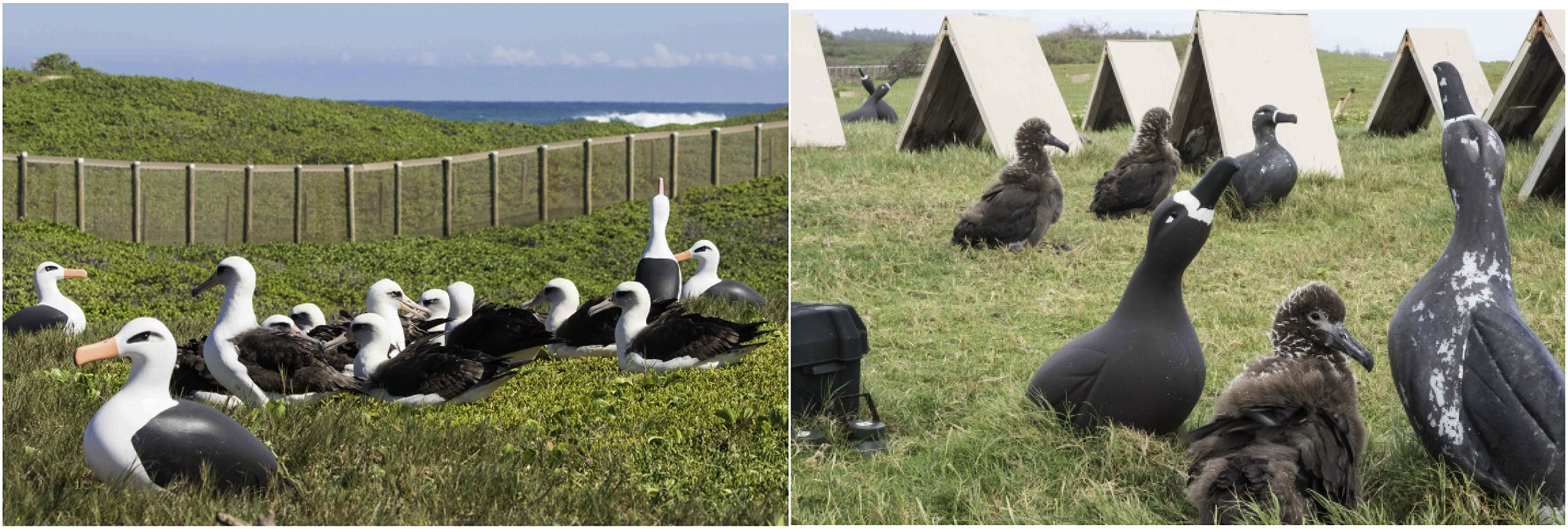Eric Vanderwerf (Pacific Rim Conservation, Honolulu, Hawaii, USA) and colleagues have published open access in the journal Global Ecology and Conservation on a project to create new colonies of Black-footed Phoebastria nigripes and Laysan P. immutabilis Albatrosses on the Hawaiian island of Oahu safe from sea level rise.
The paper’s abstract follows:
“The Northwestern Hawaiian Islands support some of the largest tropical seabird colonies in the world, but these low-lying islands are threatened by sea level rise and increasing storm surge associated with climate change. Protection of suitable nesting habitat and creation of new breeding colonies on the higher main Hawaiian Islands are among the highest priority conservation actions for these seabirds. From 2015 to 2018, we used social attraction and translocation to begin establishing new colonies of two vulnerable seabirds, Laysan albatross and black-footed albatross, inside a 6.6-ha predator-exclusion fence at James Campbell National Wildlife Refuge, Oahu. Social attraction with decoys and playbacks of recorded vocalizations resulted in increasing visitation by Laysan albatrosses, with a maximum of 343 visits per year, and the first nesting attempt in 2017. We also translocated 50 Laysan and 40 black-footed albatross chicks to the site when they were 2–4 weeks old and raised them by hand until fledging. On average, the translocated chicks attained a higher body mass, longer wing chord, and fledged 2–3 weeks earlier than naturally-raised chicks. The fledging rate was ≥90% both species. The first translocated bird from the 2015 cohort returned to the release site in 2018, and we expect more translocated birds to return at age 3–5 years and to begin breeding there at age 7–9 years. We expect that continued social attraction of Laysan albatrosses and return of birds already translocated will be enough to establish a colony. For black-footed albatrosses, social attraction is unlikely to contribute to colony establishment during the initial stages, and we plan to translocate 40-50 additional chicks over two more years. The methods we developed to hatch, feed, and fledge albatrosses will be useful for similar projects involving translocation of other seabirds.”

Social attraction systems for Laysan Albatross (left) and Black-footed Albatross (right) at James Campbell National Wildlife Refuge, Oahu. Each system played vocalizations of the target species and had 10-20 plastic decoys in sitting and bill-pointing postures. Also visible at right are A-frame shelters provided to each chick [from Vanderwerf et al. 2019].
Read 20 earlier ALN postings on albatross management efforts at the James Campbell National Wildlife Refuge.
Reference:
VanderWerf, E.A., Young, L.C., Kohley, C.R., Dalton, M.E., Fisher, R., Fowlke, L., Donohue, S. & Dittmar, E. 2019. Establishing Laysan and black-footed albatross breeding colonies using translocation and social attraction. Global Ecology and Conservation doi.org/10.1016/j.gecco.2019.e00667.
John Cooper, ACAP Information Officer, 24 July 2019

 English
English  Français
Français  Español
Español